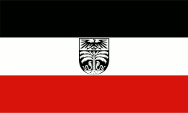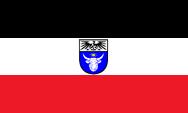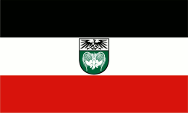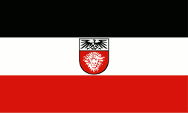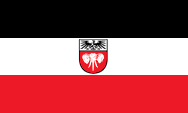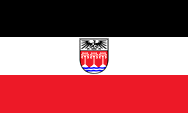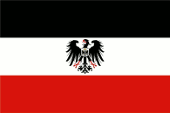Die Flaggen der deutschen Kolonien – The flags of the German Colonies |
|
| Die deutschen Kolonien unterstanden – Kiautschou ausgenommen – dem Reichskolonialamt. Entsprechend verwendeten Behörden dessen Siegel, Flaggen und das Reichswappen. |
The German colonies – except Kiaochow – had been subordinated under the Imperial Colonial Office.
Accordingly, public authorities used its seals, flags, and the Imperial coat of arms. |
| Ab 1913 wurde überlegt, für die Kolonien eigene Hoheitszeichen zu schaffen. Erste Entwürfe lagen 1914 vor, jedoch wurde das Projekt wegen des Ausbruchs des Ersten Weltkriegs und wegen des Verlusts der Kolonien nicht mehr realisiert. |
From 1913 it was considered to create own emblems for the colonies. First drafts were made in 1914, but the project was not realized because of the outbreak of the First World War and because of the loss of the colonies. |
| Das gedachte Aussehen der Wappen und Flaggen konnte in den 20er und 30er Jahren des 20. Jahrhunderts anhand von Fragmenten lediglich rekonstruiert werden. Die meisten Rekonstruktionen beziehen sich auf einen Artikel der Zeitung "Afrika-Nachrichten" von 1933 und die daraus folgenden Rekonstruktionen des niederländischen Vexillologen Mark Sensen vom Februar 1998, die auch auf diesen Seiten berücksichtigt werden. |
The imaginary appearance of the coats of arms and flags could only be reconstructed on the basis of fragments in the 20s and 30s of the 20th century.
Most of the reconstructions refer to an article in the newspaper "Afrika-Nachrichten" from 1933 and the subsequent reconstructions of the Dutch vexillologist Mark Sensen from February 1998, which are also taken into account on these pages. |
| Die Wappen selbst sollten oberhalb des Wappenschilds noch die Kaiserkrone tragen, jedoch nicht auf den Flaggen, wenn man der Rekonstruktion von Mark Sensen folgt. | The coats of arms themselves should additionally show the imperial crown above the escutcheon, but not on the flags, following the reconstruction of Mark Sensen. |
|
Die Wappenschilde zeigten immer den gleichen Aufbau: Ein horizontal zweigeteiltes Schild, dessen Schildhaupt auf weiß den Reichsadler mit dem Brustschild des Hauses Hohenzollern zeigte. Im Hauptteil eine stilisierte Darstellung von Pflanzen, Tieren oder Landschaften, die je nach Land unterschiedlich gefärbt waren. |
The escutcheons always showed the same structure: A horizontally twofold splited shield, the head of the shield showed the imperial eagle on white ground with the escutcheon of the House of Hohenzollern on the chest. In the main part appeared a stylized representation of plants, animals or landscapes, which were colored differently depending on the country. |
